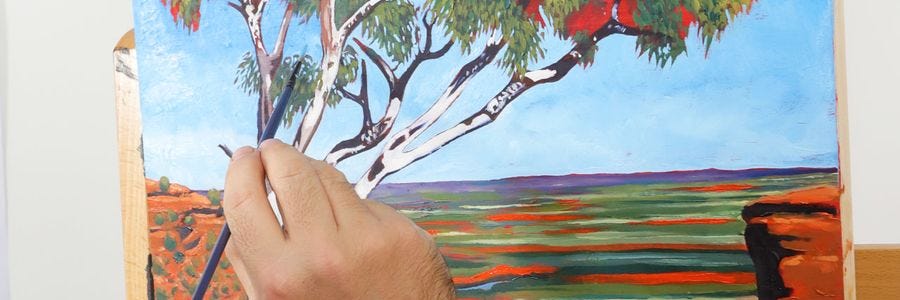Are you brushing up on your impressionism skills or trying it out for the first time? We recently painted an impressionist landscape, so we thought we’d share a few quick tips from what we learnt along the way.
1. Choose the right surface

Impressionist artworks can be created on most surfaces, but choosing a firm one will make life a lot easier if you’re working outside.
2. Pay attention to light
Light will impact the mood and atmosphere of your impressionist landscape, so take some time to look carefully at your subject. Light is also key to creating the illusion of distance. Cool colours recede and warm colours appear closer, so put your cool tones in the background and warm tones in the foreground.
3. Keep your colours clean

To create clear and realistic colours, mix them with a palette knife and wipe it clean after each colour is mixed. This will stop them from getting muddy and will keep them nice and bright.
4. Less is more
While we’re on the topic of colour, less is more with impressionism. Using a small selection of colours will keep them clean and usually makes it easier to create colour harmonies. If you need some pointers, check out the suggested palette in our impressionist desert scene tutorial.
5. Choose suitable paint brushes

You can use any paint brush, but filbert brushes are the crowd favourite when it comes to impressionism. They have a round tip that doesn’t create hard edges and can be used to create curved marks. Stiff bristle brushes are also a good go-to because they have stiffer bristles which help create textural brush strokes (a big part of impressionism).
6. Keep it simple
Try not to get caught up on the details. Break down your scene into a foreground, mid-ground and background, and then use basic shapes to bring your scene to life.
7. Use bold brush strokes

Impressionists use quick, short brush strokes to create movement and texture. This method also allows you to rapidly paint a live scene without getting stuck in the details.
8. Use colours in shadows
At first glance, shadows in a painting can look like they’re created with grey or black paint. But take a closer look and you’ll find that they actually have some colour mixed into them. Take a close look at the shadows in your scene and introduce some colour to create depth.
9. Use the colours you see not the colours you know

Impressionism is all about observation, so you’ll want to look very carefully at your subject. For example, we know that the sky is blue, but maybe the sky you’re painting has a tinge of red or mauve. Instead of relying on what you know, paint from what you see.
10. Don’t overwork the painting
They say it takes two artists to create a painting; one to paint and another to tell them when to stop. This is very true when it comes to impressionism. Put in what you need to and leave it at that. Overworking a painting can undo some of the movement and spontaneity that has been created in an artwork.
Now that you’ve got a few tips up your sleeve, we hope you feel ready to create your very own impressionist landscape. We’d love to see what you’ve created, so feel free to share it with us on Facebook or Instagram using @montmarteart.





























